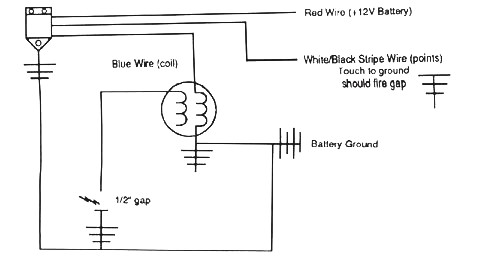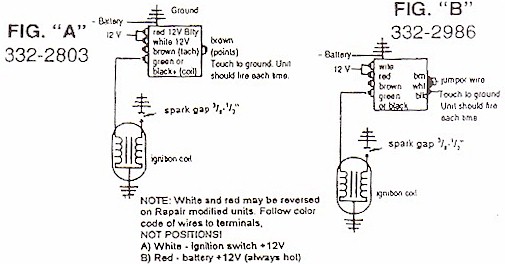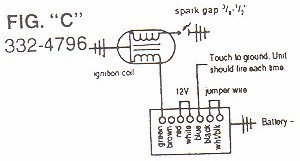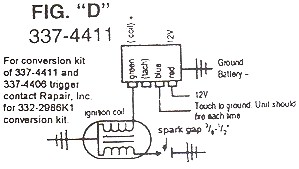| Recommended Tools: |
| for DVA: |
Fluke Multimeter with CDI #511-9773 Peak Adapter, (or
CD-77) and CDI #511-9770 |
|
CDI #511-9701 Battery CD Tester |
|
CDI #511-9766 Spark Gap Tester |
|
Jumper wires |
|
A Reliable Volt/Ohm Meter (if the CD-&& is
used for the DVA |
| CAUTION; DO NOT Use A MAINTENANCE FREE
Battery with these Types of ignitions As they tend to overcharge and blow the
packs. > Typically 17 Volts +. |
| |
| Note: A large portion of the problems with the
battery CD units are caused by low battery voltage or bad ground
connections or high battery voltage. Low Voltage symptoms are
weak erratic firing of cylinders. Misfiring after a few minutes
of running can be caused by excessive (Over 15.5 Volts DC)
voltage at the pack - See #2 below. |
| |
| 1) Check all battery and ground
connections. |
| |
| 2) Check the Voltage on the red (or
purple) wire at the CD Unit. |
| If the voltage is less than 9 1/2
volts during the cranking there is a problem in the battery
circuit. These units require at least 9 1/2 volts to fire
properly. Connect a jumper wire directly from the battery (+)
terminal to the red (or purple) wire. Retest. ATTENTION: In order
to kill the engine if it cranks, the jumper wire must be
disconnected and/or choke the engine. If the engine still fails
to crank, recheck voltage as above. If low, replace the battery
and retry. Warning: Check he voltage on the red
(or purple) wire at the CD Unit through the RPM range. At no time
should the voltage exceed 15.5 Volts DC. |
|
| |
| 3) Disconnect points and/or sensor wire and connect a battery tester. |
| Hook up the Battery CD Tester according to the
operators manual and align rotor with spark plug wire. Connect a
spark gap to all spark plug wires and turn the Ignition switch
on. If the CD Unit fires only to one spark plug wire, check the
points, sensor, anti-reverse spring and wires for breaks and
shorts. If ANY other spark plug wire fires besides the one the
rotor is aligned with, the distributor cap and rotor should be
replaced. The Battery CD tester will fire the system to
approximately 3000 RPM. If the Battery CD tester (511-9701) is
not used, strike points wire against engine ground. for the
sensor, strike the two wires together. The CD Unit should fire
every time. If the CD Unit fails to fire, it is usually bad. |
|
| |
| 4) Points type
Ignition. |
| Disconnect points wire and check voltage on the
points wire. You should read close to battery voltage with the
key switch on. No voltage means a bad pack. If OK, reconnect the
points wire. Using the piercing probes (511-9770) connect the DC
volt meter to the points wire. Turn the switch on and slowly
rotate the flywheel. You should see the voltage fluctuate up and
down. |
|
| |
| 5) Check the Ignition
coil. |
| An open, cracked or poorly grounded coil can
burn out a battery CD Unit. |
|
| |
| 6) Check the DVA voltage on the
primary input wire to the coil. |
| Reading should be approximately 200 volts or
more. |
|
| |
| 7) Simplified bench
test: |
 |
| |
|
Troubleshooting OMC Power Packs and CD's
|
| |
| Recommended Tools: |
| for DVA: |
Fluke Multimeter with CDI #511-9773 Peak Adapter, (or
CDI #511-9770 Piercing Probes |
|
CDI #5119-710 Trigger tester (for use with '88-'96
V8, V8 Quick Start timer Bases |
|
CDI #511-9766 Spark Gap Tester |
|
CDI #553-2697, 553-2698, 553-2699 Pin Removal and
Insertion Tools |
|
CDI #553-9702 Gap Gauge |
|
Jumper wire |
| Note: If CD-77 is used for DVA,
you will need a good volt/ohm meter. |
| |
| NOTICE: Initial DVA readings
should be taken with everything hooked up. |
| |
| 1) Check the flywheel for cracked and
lose magnets. |
|
| 2) Disconnect the kill wire(s) from the
pack and retest. |
| Connect a DC voltmeter between the kill wires
and engine ground. Turn the Ignition switch on and off several
times. If at any time, you se DC voltage appearing on the meter,
there is a problem in the battery Harness or the Ignition switch.
NOTE: At no time should you see battery voltage on any kill wires. |
|
| |
| 3) Visually inspect Stator for cracks or
leaks: |
| If found, replace the Stator, Burnt marks of
discolored areas on the battery charge windings indicates a
possible problem with the rectifier. |
|
| |
| 4) Unit will not fire: |
| Disconnect the kill wire AT the Pack. Check for
bare or broken wires on the Unit, Stator and timer base. Measure
DVA voltage of the Stator with everything connected. Readings
should be approximately 150 volts or more. On Standard CD types,
check DVA voltage on the timer base white wire. Voltage should be
approximately 150 volts or more (Quick Start units usually have
the white wire tied to ground inside the pack). If the reading is
good on the Stator but low on the white wire, the timer base is
usually bad. Disconnect the rectifier. If the engine fires,
replace the rectifier. |
|
| |
| 5) '88-'98 V6-V8 and 93-98 3 cylinder
Quick Start timer bases: |
| Disconnect the timer base. Using the Fluke
meter, set to ohms scale, and one of the piercing probes, connect
the red lead from the meter to the white wire in the Amphenol
connector from the timer base. Use the black lead from the meter
and check to all of the pastel colored wires in both connectors
from the timer base. all of the readings should be fairly even,
normally between 1 and 2 meg ohms measured with a Fluke meter.
with the red lead still connected to the white wire, connect the
black meter lead to the black/white wire in the opposite
connector from the timer base. You should read approximately 220
ohms. If one or more cylinders are out of line, (I.E. all the
rest are reading 1.2 -1.8 meg ohms and one reads 0.898 or 2.2 meg
ohms) the timer base is usually bad. |
|
| |
| 6) '92-'96 Looper units with optical
triggers: |
| DVA check the Stator. Each set of brown wires
should read at least 150V (950-1050 ohms) and 12 volts between
the two orange wires from the power coil (50 ohms on the gray
sleeved Stator and 97 ohms on the black sleeved Stator). Note:
These units require special spark plugs and the GRAY spark plug wires. If the pack only fires when you remove the plug connector
containing the kill wires, use a jumper wire to connect the kill wires in the pack. If the pack still fires, there is a problem in
the Harness, safety circuit or Ignition switch. A no fire
situation with the jumper in place indicates a bad pack. |
|
| |
| 7) '89-'95 4 Cylinder Looper
units: |
| If the engine misses on one cylinder with the
white/black temperature wire hooked up and does not with it
unhooked, this is usually the timer base causing the
problem. |
|
| |
| 8) for PP2, 3, and 4
units: |
| If one or more cylinders will not fire with the
spark plug installed], check the timer base resistance between
sensor leads: PP2, from white/black to
black/white; PP3 from black/white to all all
whit/blacks; PP4 1-3 and 2-4, readings should be
10-20 ohms for all sensor coils. (some of the older units with
the metal cased CD's read 8-14 ohms). Regapping may solve the
problem. CDI Gap Gauge 553-9702 is recommended for PP3 and PP4.
To regap, remove the epoxy covering and loosen the small nuts on
the center bolts going thru the heat shield. Loosen the anchor
screws holding down the sensors. Slide the sensor in toward the
Crankshaft until it touches the gap gauge. (553-9702) or the
metal stop at the bottom of the sensor. Paint the face of the
sensor or the Trigger magnet on the flywheel, with a contact
detector, and reinstall the flywheel. Crank the engine over
several times and remove the flywheel, checking to see if the
Trigger magnet is striking the sensor face. |
|
| |
| 9) Engine will not kill: |
| Remove the black/yellow kill wire from the
rubber connector to see if the pin is broken. Check the kill
circuit in the pack by using a jumper wire connected to the
black/yellow wire coming out of the pack and shorting it to
ground. If this kills the engine, the kill circuit in the Harness
or the boat is bad, or the Ignition switch is bad. |
|
| |
| 10) Coils fire with spark plugs out but
not in: |
| Check for dragging starter or low battery
causing slow cranking speed. DVA test the timer base. |
|
| |
| 11) Engine runs rough on one bank (4, 6
and 8 cylinder engines with CD ignitions): |
| DVA check Stator voltage to both sides. The
readings should be fairly equal. If it exceeds 400 volts, replace
the pack on the bank. If unequal, swap banks with the Stator
leads and see if the problem moves with the Stator leads. If it
does, replace the Stator. Disconnect one of the black/yellow kill wires, AT the Pack. If the problem goes away, replace the pack
that was running smooth as is probably has a bAdBlocking
diode. |
|
| |
| 12) Intermittent firing on one or more
cylinders: |
| Can be caused by low voltage from the Stator of
a bad timer base. DVA test Stator and timer base. Disconnect the
rectifier and retest. If the problem disappears, replace the
rectifier. If it doesn't replace the pack |
|
| |
| 13) Check for broken wires and
terminals; |
| Especially check inside the rubber Amphenol
plug-in connectors. We recommend that you remove the pins from
the connectors and visually inspect them. |
|
| |
|
Troubleshooting Mercury Outboard Battery CD
ignitions
|
| |
| Recommended Tools: |
| for DVA: |
Fluke Multimeter with CDI #511-9773 Peak Adapter,
(or CD-77) |
|
CDI #511-9701 Battery CD Tester |
|
CDI #511-9710 Trigger Tester |
|
CDI #511-9766 Spark Gap Tester |
|
Jumper wires |
|
A Reliable Volt/Ohm Meter (it the CD-77 is used for
the DVA) |
| CAUTIon; DO NOT Use A MAINTENANCE FREE
Battery with these TypeS of ignitions As theY TEND To OVERCHARGE
and BLOW the Packs. Typically 17 Volts +. |
| |
| Note: A large portion of the
problems with the battery CD units are caused by low battery
voltage or bad ground connections or high battery voltage. Low
Voltage symptoms are weak erratic firing of cylinders. Misfiring
after a few minutes of running can be caused by excessive (Over
15.5 Volts DC) voltage at the pack. - Warning :
Check the voltage on the red (or purple) wire at the CD Unit
through the RPM range. At no time should the voltage exceed 15.5
Volts DC. |
| |
|
Warning!! BATTERY REVERSAL WILL USUALLY
DESTROY BATTERY CDs AND TRIGGERS.
|
| |
| 1) Check all battery and ground
connections. |
|
| 2) Dead or no fire until you release
the key switch: |
| Disconnect the Mercury Outboard switch and
reset, if the engine fires, replace the Mercury Outboard switch. Check the
voltage on the red and white Ignition wires at the CD Unit. If
the voltage is less than 9 1/2 volts during cranking there is a
problem in the battery s or the Ignition switch box. These units
require at least 9 1/2 volts to fire properly. On a 332-2986
switch box, check the voltage on the brown terminal (white/black
for 332-47960 where the Trigger is hooked up. It requires at
least 9V at cranking. DVA check between the white and black wires (black and blue on 332-4796). You should read at least 2
1/2 volts at cranking. Connect a jumper wire directly from the
battery POS (+) terminal to the red and white Ignition wires (the
red wire is not needed for the CDI units). CAUTION: DO NOT
Connect the jumper wire to the WHITE Trigger Terminal. Retest: ATTENTION: in order to kill the engine if it cranks, the jumper
wire has to be disconnected and/or choke the engine. If the
engine still fails to crank, recheck voltage as above. If low,
replace the battery and retry. If there is still no fire,
disconnect points wire (or Trigger wires) and connect the Battery
CD tester (511-9701), according to the instructions in the
manual, and align the rotor with a spark plug wire. Connect a
spark gap tester (511-9766) to all spark plug wires and turn the
Ignition switch on. If the CD Unit fires to only one spark plug wire, check points
wire (for breaks or shorts) or Trigger. If ANY
other spark plug fires besides the one the rotor is aligned with,
the distributor cap and rotor should be replaced. The Battery CD
tester will fire the system to approximately 3000 RPM. If the
Battery CD tester is not used, see related drawings on the
Schematic page (following). If the CD Unit fails to fire with
this hookup, it is usually bad. Following the instructions
included with the Trigger Tester (511-9710) check the Trigger to
see if it is good or bad. |
|
|
|
| 3) Engine cranks and fires as long as
starter is engaged: |
| This problem usually indicates a bad
Trigger. |
|
|
|
| 4) Check the Ignition
coil. |
| An open, cracked or poorly grounded coil can
burn out a battery CD. |
|
|
|
| 5) Check the DVA voltage on the
primary input wire to the coil. |
| Using the fluke meter with the peak reading
voltage adapter (5111-9773), or CD 77. The reading should be
approximately 100 volts or more for OEM CD's, and 200+ for CDI
electronics units. |
|
|
|
| 6) Inline engines with internal
exhaust plate: |
| If the engine speeds up when you remove one
spark plug wire, the internal exhaust plate is more than likely
warped. The following tests can be performed on the bench or on
the engine. NOTE: Disconnect the Trigger mechanism prior to
testing. |
|
| |
|
Basic Mercury Outboard
Schematics
|
| |
|

|
| |
 |
 |
| |
|
Troubleshooting Mercury Outboard Alternator
Driven Ignition
|
| |
| Recommended Tools: |
| for DVA : |
Fluke Multimeter with CDI #511-9773 Peak Adapter
and: |
|
CDI #5119770 Piercing Probes |
|
CDI #511-9710 Trigger Tester |
|
CDI #511-9766 Spark Gap Tester |
|
Jumper wire |
|
A Reliable Volt/Ohm Meter (it the CD-77 is used for
the DVA) |
| |
| NOTICE: Initial DVA readings
should be taken with everything hooked up. |
| |
| 1) Disconnect the kill wire(s): |
| Connect a DC volt meter between the kill wires
and engine ground. Turn the Ignition switch in and off several
times. If, at any time, you see DC voltage on the kill wires,
there is a problem with the Harness of Ignition switch. Battery
voltage on the kill circuit will destroy most CD units. |
|
| |
| 2) Visually inspect Stator for cracks
or varnish leakage: |
| If found, replace the Stator. Burned marks or
discolored areas on the battery charge windings indicate a
possible problem with the rectifier. |
|
| |
| 3) Unit will not
fire: |
| Disconnect kill wire AT the Pack. Check for
broken or bare wires on the Unit, Stator and Trigger. Check the
DVA voltage of the Stator, (on 3 and 6 cylinder models read from
each red and blue wire to engine ground; on 4 cylinder models
read between the two red wires and between the two blue wires),
with everything connected. The readings should be approximately
180 volts or more on the blue wires. and 30 or more volts on the
red wires. Disconnect the rectifier. If the engine fires replace
the rectifier. |
|
| |
| 4) Engine will not
kill: |
| Check the kill circuit in the pack by using a
jumper wire connected to the black/yellow terminal or wire coming
out of the pack and shorting to ground. If this kills the engine,
the kill circuit in the Harness or on the boat is bad, possibly
the Ignition switch. |
|
| |
| 5) High Speed Miss: |
| Disconnect the rectifier and retest. If the miss
is gone, the rectifier is usually at fault. If the miss still
exists, check the DVA voltage (between the red wires on 4
cylinder, or red wires to engine ground on 3 &6 cylinder) of
the Stator at high speed. NOTICE: Use caution when doing this and
do not exceed the rated voltage range of your meter. The readings
should show a smooth climb in voltage. If there is a sudden or
fast drop in voltage right before the miss becomes apparent, the
Stator is usually at fault. If there is no indication of the
problem, it could be a small water leak in one or two
cylinders. |
|
| |
| 6) Coils fire with spark plugs out but
not in: |
| Check for dragging starter or low battery
causing slow cranking speed. DVA test Stator and Trigger.
Disconnect rectifier, regulator and retest. If the problem goes
away, replace the rectifier and/or regulator. |
|
| |
| 7) Engine runs rough on top or bottom
two cylinders (4 cylinder engines): |
| Check DVA voltage of the Stator between blue wires and to ground. Readings to ground should be fairly equal.
If unequal, swap Stator leads (blue with blue/white, red with
red/white) and see if the problem moves with the Stator leads. If
it does, replace the Stator. Check Trigger resistance between #1
& #2, compare to resistance between #3 & #4. The readings
should be approximately 850 to 1250 ohms for OEM (950 ohms for
CDI). for test purposes only, swap the Trigger leads 1 &3,
and 2 &4. If the problem moves, replace the Trigger. If it
does not move, swap coil primary wires, and replace the pack if
the problem remains on the same cylinder. |
|
| |
| 8) No fire on one bank (odd or even
cylinders on inline 6 cylinder engines): |
| Check the DVA voltage of the Stator, checking
from each red wire to engine ground. The readings should be
approximately 180 volts or more on the blue wires and 30 or more
on the red wires. if a DVA meter is not available, swap both sets
of the Stator wires between the packs. If the problem moves,
replace the Stator. If the problem stays on the same bank, swap
physical location and all connections of the two packs. If the
problem stays with one pack, replace the pack. NOTE: If the pack
is bad, it is recommended that BOTH packs be replaced if the
packs are not manufactured by CDI or Rapair. If the packs
lose ground, internally or externally, the packs manufactured by
other sources usually have severe damage to the bias circuit and
need to be replaced as a set. The packs manufactured by CDI will
withstand loss of ground connection, normally with no damage to
the bias circuitry. In most cases you will just lose fire. |
|
| |
| 9) Intermittent firing on one or more
cylinders: |
| Disconnect the white/black wire between the
packs on a 6 cylinder and retest. If all cylinders now fire,
replace both packs as there is a problem in the bias circuitry.
On all others, check for low voltage from the Stator and Trigger.
Disconnect the rectifier and retest. If the problem disappears,
replace the rectifier. |
|
| |
| 10) all cylinders fire but the engine
will not crank and run: |
| On 3 and 6 cylinder engines, disconnect
white/black wire and check the bias circuit (white/black
terminals) resistance to engine ground. Readings should be
approximately 15,000 Ohms for Standard packs and 9,600 Ohms for
racing units. If the readings are correct on the packs, index the
flywheel and check the timing on all individual cylinders. If the
timing varies, replace the pack. On 4 cylinder engines the bias
circuit is internal, therefore the only way to verify proper
operation of the bias circuit is to index the flywheel and check
the timing on each cylinder. If the timing is off, replace the
packs. |
|
|
|
|
Return To: CDI Troubleshooting
home page
|



